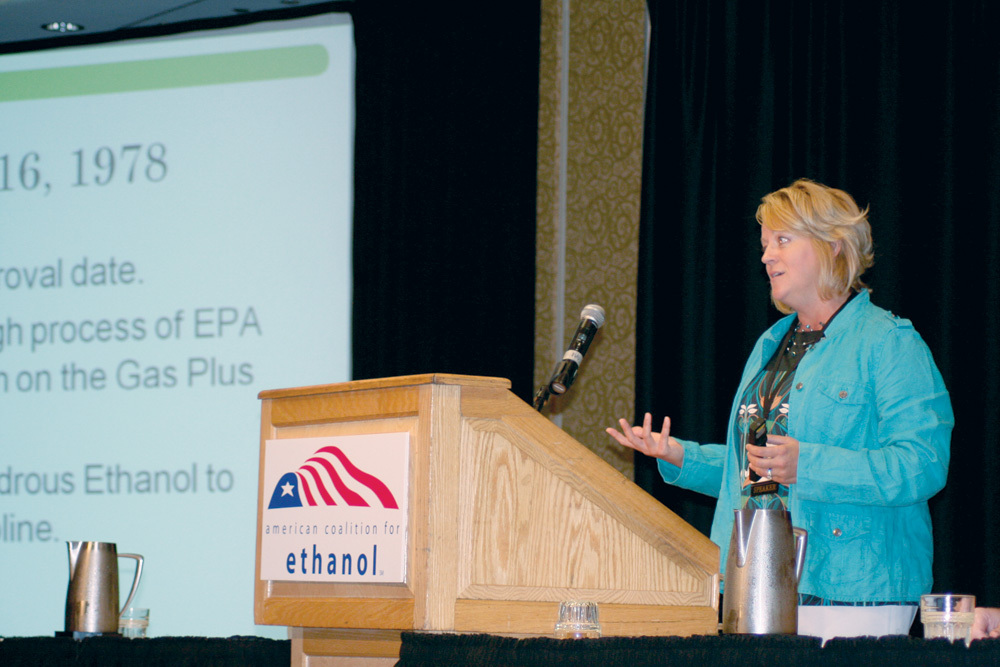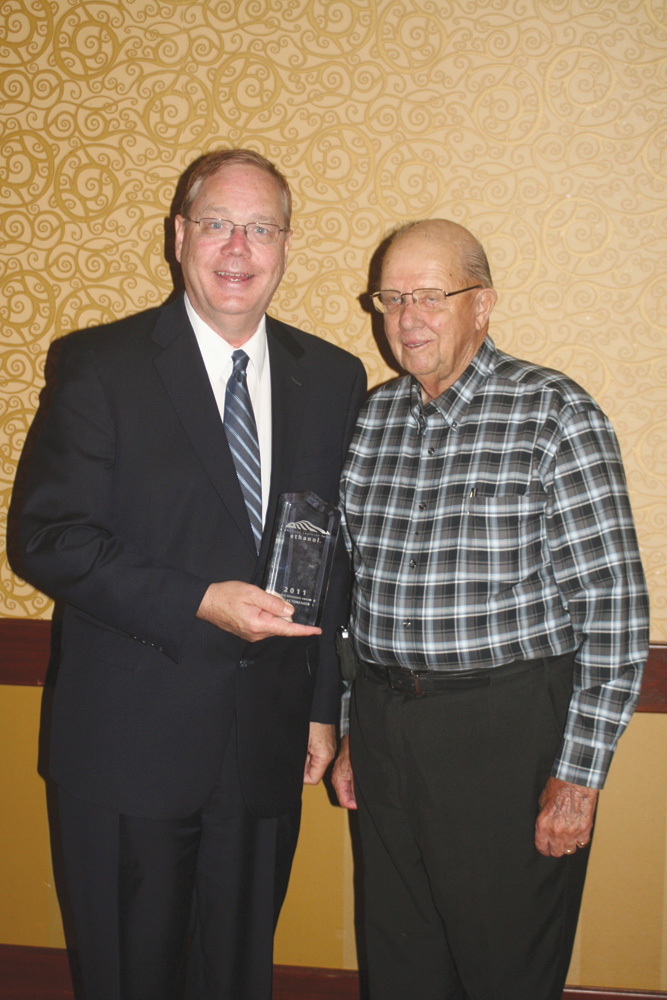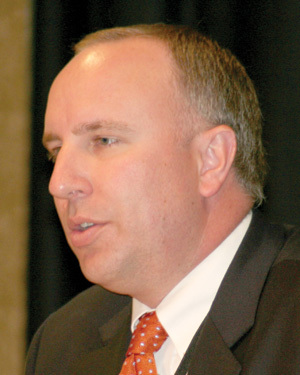Preparing for E15




PHOTO: LACEY DIXON, ACE
September 12, 2011
BY Holly Jessen
Speakers Kristy Moore and Monte Shaw represented two sides of the same coin at the 2011 American Coalition for Ethanol Conference, which had the theme “Rooted in America.” About 225 people attended the event, which was held Aug. 22-24 in Des Moines, Iowa.
Moore, director of technical services for the Renewable Fuels Association, went over what it will take to get E15 through the many and complex federal, state and local regulatory hurdles before the fuel can be sold at retail stations. As Executive Director of the Iowa Renewable Fuels Association, Shaw talked about that state’s efforts to move to selling E15 at retail gas stations while stressing the importance of clearing those regulatory hurdles first. “No amount of promotion will undo the damage or the hurt caused if we lose a technical battle,” Shaw said.
Starting with some history, Moore pointed out that the E10, or gasohol, waiver approval of 1978 happened by default. It was approved simply because the U.S. EPA failed to make a decision on the waiver before the deadline. By 2007, 10 percent ethanol was being blended into approximately 50 percent of the nation’s fuel supply, with Minnesota and Connecticut the only states at 100 percent of the supply. By 2010, E10’s market penetration had greatly improved—with 10 percent ethanol being blended into about 90 percent of the U.S. gasoline supply. Only six or seven states are on the lower end with E10 penetrations of 60 to 70 percent. That’s a remarkable transformation, she pointed out.
EPA approval of the E15 waiver for passenger vehicles model year 2001 and newer was finalized at the end of January. Although 2000 model vehicles and older were not part of the waiver, it does represent 65 percent of the vehicles on the road today. Since that time, the RFA and others have been working to take the needed steps to bring this fuel to the marketplace. For example, nearly $1 million has been spent to complete health effects testing/fuel registration requirements. Although progress has been made, there’s more to be done and Moore was not able to say when the process would draw to an end. “I don’t have a date,” she told conference-goers.
Some of the remaining impediments include fuel quality/specification issues, octane certification, fuel detergent certification, automaker warranties, missfueling liability, underground storage tank regulations and safety and emergency response information. In some states, regulations will need to be changed, as some have legislated that their fuel supply shall contain no more than 10 percent ethanol. Another issue is that in December, Underwriters Laboratories said that fire marshals could approve existing fuel dispenser equipment for the use of E15. Later, the product safety certification organization reversed that decision, Moore said.
Advertisement
Make no mistake; changing the nation’s fuel is a serious and complicated process that will take time. “We just want a chance and we just want a fair chance,” she said.
Following Moore’s talk, Shaw spoke about the Iowa model for moving E15 to the consumer. “Iowa is going to be ready to go on the first day E15 is legal to sell,” he said.
The state has 41 ethanol plants that produce nearly 3.7 billion gallons of ethanol yearly and has been working hard to prepare for the day the technical hurdles have been overcome. “The fact of the matter is, Iowa has a heck of a lot riding on E15,” he said. “If we solve this, there will be a pot of gold at the end of the renewable rainbow,” he added later, to laughter from the audience. E15 is vitally important to the short-term success of the ethanol industry and using existing infrastructure is vital for the success of E15, he said. One way the industry has stayed afloat is by exporting increasingly larger amounts of ethanol to Brazil, but that option won’t always be available. “We’re one successful sugarcane harvest from having plants shut down, in my opinion,” he said.
In preparation for E15, Iowa passed a law this year that says retailers are not liable for damage caused by the use of an incompatible motor fuel. The law says that the fuel must have been chosen by the consumer from a correctly labeled dispenser and it must comply with fuel specifications. Shaw told the audience similar laws need to be passed in other states and that it might be one of the most important steps to bringing E15 to the marketplace.
Advertisement
To help retailers sell E15, Iowa also approved a new tax credit that was put into place July 1. Retailers that sell blends of E15 to E66 are eligible for a 3 cent tax credit through 2014, and a 2 cent tax credit from 2015 to 2017, he said. In addition, the state has $3 million allocated annually for infrastructure grants to install blender pumps, E85 pumps and biodiesel dispensers or blending terminals. The funds can be used for up to 70 percent of the installation cost, or a maximum of $50,000. It’s not currently known if E15 system upgrades will qualify under that program, Shaw said.
In Iowa, regulations allow E15 to be sold through existing dispensers. That decision was made after the dispenser manufactures stated that their pumps are compatible with and warranted for E15. Also, this was before the UL reversed its decision on existing dispensers, he said. On the underground storage tank side, Iowa previously used an E85 compatibility checklist and will implement a similar E15 checklist according to recent EPA guidance.
As for an E15 ASTM spec, Shaw advocates moving ahead without it, knowing it will happen later on. Although E10 and E85 both have specs, Iowa state law doesn’t reference an ASTM spec and was crafted specifically to allow midlevel ethanol blend sales. “Yes, an ASTM spec is preferable but waiting two years is not,” he said, referring to the time it could take to get an ASTM spec approved for E15. Much work remains to clear up gray areas so more of Iowa’s 3,000 retailers will feel comfortable offering E15 at their stations. What will be needed in the beginning, however, is encouraging retailers willing to “stick their toes in the somewhat murky waters” and go for it. Once that happens, and other retailers see that it works, more will follow.
Ron Lamberty, senior vice president of ACE agreed. “Basically, we’ve got to make sure it’s legal and then somebody has got to do it,” he said. Brian Jennings, executive vice president, added that bringing E15 to the marketplace will mean near-term relief and opportunity for the industry. Adding more blender pumps and flex-fuel vehicles will also continue to be a high priority for ACE, he said.
In all, more than 30 speakers and moderators spoke on topics such as the likely demise of the Volumetric Ethanol Excise Tax Credit, the health effects of ethanol, the effect of food safety laws on distillers grains production, cellulosic ethanol, managing high margins and more. Keynote speakers included Stephanie Herseth Sandlin, a former S.D. congresswoman; Sen. Tom Harkin, D-Iowa, and Dallas Tonsager, under secretary for rural development with the USDA.
—Holly Jessen
Upcoming Events





